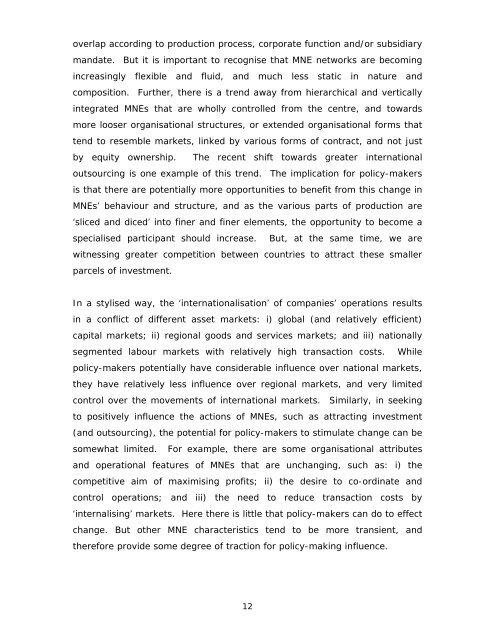(EGM) Foreign Direct Investment in Southeast Asia - Unido
(EGM) Foreign Direct Investment in Southeast Asia - Unido
(EGM) Foreign Direct Investment in Southeast Asia - Unido
Create successful ePaper yourself
Turn your PDF publications into a flip-book with our unique Google optimized e-Paper software.
overlap accord<strong>in</strong>g to production process, corporate function and/or subsidiary<br />
mandate. But it is important to recognise that MNE networks are becom<strong>in</strong>g<br />
<strong>in</strong>creas<strong>in</strong>gly flexible and fluid, and much less static <strong>in</strong> nature and<br />
composition. Further, there is a trend away from hierarchical and vertically<br />
<strong>in</strong>tegrated MNEs that are wholly controlled from the centre, and towards<br />
more looser organisational structures, or extended organisational forms that<br />
tend to resemble markets, l<strong>in</strong>ked by various forms of contract, and not just<br />
by equity ownership. The recent shift towards greater <strong>in</strong>ternational<br />
outsourc<strong>in</strong>g is one example of this trend. The implication for policy-makers<br />
is that there are potentially more opportunities to benefit from this change <strong>in</strong><br />
MNEs’ behaviour and structure, and as the various parts of production are<br />
‘sliced and diced’ <strong>in</strong>to f<strong>in</strong>er and f<strong>in</strong>er elements, the opportunity to become a<br />
specialised participant should <strong>in</strong>crease. But, at the same time, we are<br />
witness<strong>in</strong>g greater competition between countries to attract these smaller<br />
parcels of <strong>in</strong>vestment.<br />
In a stylised way, the ‘<strong>in</strong>ternationalisation’ of companies’ operations results<br />
<strong>in</strong> a conflict of different asset markets: i) global (and relatively efficient)<br />
capital markets; ii) regional goods and services markets; and iii) nationally<br />
segmented labour markets with relatively high transaction costs. While<br />
policy-makers potentially have considerable <strong>in</strong>fluence over national markets,<br />
they have relatively less <strong>in</strong>fluence over regional markets, and very limited<br />
control over the movements of <strong>in</strong>ternational markets. Similarly, <strong>in</strong> seek<strong>in</strong>g<br />
to positively <strong>in</strong>fluence the actions of MNEs, such as attract<strong>in</strong>g <strong>in</strong>vestment<br />
(and outsourc<strong>in</strong>g), the potential for policy-makers to stimulate change can be<br />
somewhat limited. For example, there are some organisational attributes<br />
and operational features of MNEs that are unchang<strong>in</strong>g, such as: i) the<br />
competitive aim of maximis<strong>in</strong>g profits; ii) the desire to co-ord<strong>in</strong>ate and<br />
control operations; and iii) the need to reduce transaction costs by<br />
‘<strong>in</strong>ternalis<strong>in</strong>g’ markets. Here there is little that policy-makers can do to effect<br />
change. But other MNE characteristics tend to be more transient, and<br />
therefore provide some degree of traction for policy-mak<strong>in</strong>g <strong>in</strong>fluence.<br />
12

















